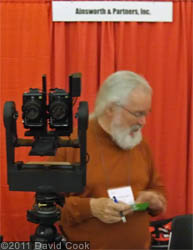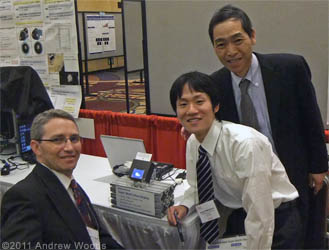|
This year a wide selection of 3D hardware and 3D software products were on show at the demonstration session.

[D0] Panorama of the Demonstration session.



[D1] JVC (Rod Sterling) demonstrated a pre-release version of the new GS-TD1 Full-HD stereoscopic camcorder which is scheduled for release in March 2011.



[D2] NVIDIA (Dave Cook and Michael McSorley) showed a 3D Vision Surround system consisting of the 3D Vision product running across three screens (Alienware AW2310 120HZ 3D LCD monitors) viewed with 3D Vision active shutter glasses and running the game Mafia 2. Graphics cards used were two GeForce GTX580s.



[D3] DDD (Julien Flack and his team) demonstrated their TriDef 3D game and 3D video software driving a large screen 3D TV and two 3D notebook computers all viewed with active shutter glasses - specifically:
(1) an HP Envy 17" 3D notebook running EA's Need for Speed Hot Pursuit in 3D,
an Acer 5738DG 3D notebook demonstrating TriDef 3D's real-time 2D to 3D conversion process for HD video,
(2) a Samsung 3D TV driven by a standard shuttle PC with an AMD Radeon 6000 GPU connecting via HDMI, and
(3) 1.4 and using TriDef 3D's game drivers to run EA's Medal of Honor in 3D.


[D4] Ainsworth & Partners (Richard Ainsworth assisted by Dan Sandin) showed their stereoscopic panoramic photography system: two cameras on a motorized mount, with associated software.

[D5] HumanEyes (Assaf Zomet and Shmuel Peleg) demonstrated their multi-view cross-talk reduction mechanism on both an autostereoscopic monitor and on lenticular 3D prints.

[D6] Centre for Vision Research, York University, Toronto (Inna Tsirlin & Laurie Wilcox) showed the experimental stimuli for their work on evaluating the effect of crosstalk.


[D7] Ronald S. Karpf demonstrated a prototype of their continuously adjustable Pulfrich spectacles.


[D8] Accurex Measurement showed their StereoScan 3D scanning hardware and software.

[D9] Volfoni demonstrated their ActiveEyes glasses that can work with (almost) any active or passive circularly polarized display.


[D10] The University of Tsukuba (Hideki Kakeya and his team) had two demonstrations: both variations on integral imaging, using beam splitters and multiple displays to produce three-dimensional multi-view images.

[D11] The Tokyo University of Agriculture and Technology (Yasuhiro Takaki and Junya Nakamura) showed a super multi-view display with viewing zones only 2.6mm wide. Each eye had eight abutting viewing zones, so head movement was restricted. Zones this narrow allowed some people to converge and accommodate at the same depth, other than the screen depth.



[D12] Lightspeed Design (Chris Ward) demonstrated their DepthQ polarization modulator in operation with their latest DepthQ HD projector.

[D13] 3M Company (Michael Sykora, Vincent King and Glenn Casner) showed their new two-view autostereoscopic display, which is used in a recently released commercial device.

[D14] ELDIM (Pierre Boher) provided literature on their system for performance characterization of autostereoscopic displays.
|

